Related Research Articles

Bernardo Strozzi, named il Cappuccino and il Prete Genovese, was an Italian Baroque painter and engraver. A canvas and fresco artist, his wide subject range included history, allegorical, genre and portrait paintings as well as still lifes. Born and initially mainly active in Genoa, he worked in Venice in the latter part of his career. His work exercised considerable influence on artistic developments in both cities. He is considered a principal founder of the Venetian Baroque style. His powerful art stands out by its rich and glowing colour and broad, energetic brushstrokes.

Giovanni Andrea Ansaldo was an Italian painter active mainly in Genoa.
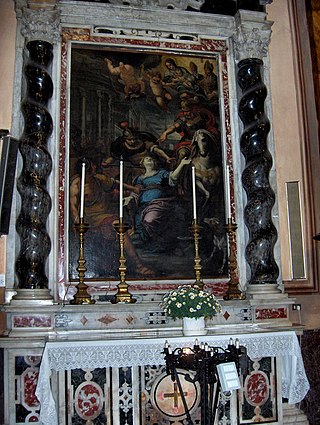
Giulio Benso was a Genovese painter of the early Baroque. He is known as one of the followers of the style of Luca Cambiasi.

Giovanni Bernardo Carlone (1590–1630) was an Italian painter of the late-Mannerist and early-Baroque periods.

The Church of Saint Anne, with the adjacent convent and pharmacy of the Discalced Carmelites, is a Roman Catholic church located in the residential quarter of Castelletto in Genoa, Liguria, north-western Italy. The village - now surrounded by the city - is still intact, with its leafy trees, cobbled walkways and open views from Salita Bachernia over the Gulf of Genoa, the harbor and the Old City.

Patrician Marco Doria, Marquis and Count of Montaldeo is an Italian academic and politician from Genoa. He served as Mayor of Genoa from 2012 to 2017.

Domenico Parodi was an Italian painter, as well as a sculptor and architect, of the late-Baroque. He was the son of the famous Genoese sculptor Filippo Parodi and the older brother of the Baroque painter Giovanni Battista Parodi (1674-1730)

Genoa is a city in and the capital of the Italian region of Liguria, and the sixth-largest city in Italy. In 2023, 558,745 people lived within the city's administrative limits. While its metropolitan area has 813,626 inhabitants, more than 1.5 million people live in the wider metropolitan area stretching along the Italian Riviera.

Giovanni Carlo Doria (1576–1625) was a Genoese art collector and mecenas. A son of Agostino Doria, doge of Genoa in 1601-1603, he was a prominent member of one of the richest and most influential families of the Republic of Genoa; his brother Giovanni Stefano Doria (1578-1641) became the 101st doge of Genoa (1633-1635) and was considered the richest man in Italy in his day. Giovanni Carlo was married to Veronica Spinola, daughter of Ambrogio Spinola. He was given the Order of Santiago by Philip III of Spain.

The Accademia Ligustica di Belle Arti is a tertiary academy of fine arts located in Genoa, Italy. It also houses a museum, which includes works of Giovanni Benedetto Castiglione, Giuseppe Abbati, Anton Raphael Mengs, Perin del Vaga, Luca Cambiaso, Bernardo Strozzi, Giovanni Battista Paggi, Sinibaldo Scorza, Domenico Fiasella, Luciano Borzone, Serafino De Tivoli, Plinio Nomellini. The academy was founded in 1751.
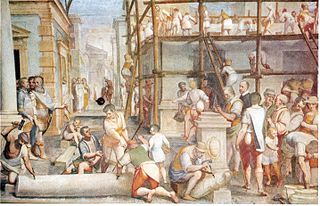
The Republic of Genoa was a rich oligarchic republic, where the authorities were powerful bankers. Unlike Florence, Ferrara, Rome, Rimini, and Venice, Genoa was not developed into a significant arts center during the Renaissance. But in the 17th century Genoa had an original school of painting, called the Genoese School, which was to develop Flemish contacts. The best painter was Bernardo Strozzi, called il Cappuccino, of great importance also for Venice. Giovanni Castiglione, called Il Grecchetto, took up a genre already made famous by Sinibaldo Scorza with paintings of animals and still lifes under Flemish and Venetian influence. Domenico Fiasella and Gioacchino Assereto joined the Caravaggesque followers, while Valerio Castello was more eclectic. The decorators Domenico Piola and Gregorio de Ferrari worked in the churches and palaces of Genoa.
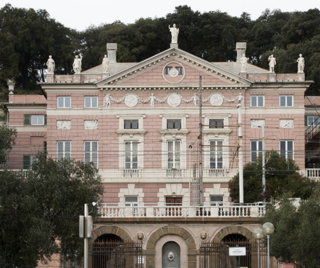
Villa Di Negro Rosazza "dello Scoglietto" or "lo Scoglietto" is a villa located in the quarter of San Teodoro in Genoa, Northwestern Italy. It was built in 1565 for the Doge Ambrogio Di Negro o for his son Orazio, in a coastal area that used to be outside of the city walls. The villa passed to the Durazzo family, who commissioned a renovation in the neoclassical style at the end of the 18th century. In the 19th century, the construction of the railway Turin-Genoa led to the destruction of the garden at the sea side, while the hill side remained largely untouched. The villa and the park are now owned by the Municipality of Genoa and destined to public use. The villa is located near the Dinegro station of the Metro of Genoa.

Villa Balbi Durazzo Gropallo "Dello Zerbino" is a 16th-century villa in Genoa, Italy. It is situated in the quarter of Castelletto, near Galeazzo Alessi's Villa delle Peschiere. It was constructed from 1599 to 1603 as a suburban villa for the Genoese noblemen Stefano Balbi, ambassador to Milan, and Giovanni Battista Balbi. The name Zerbino is derived from the Ligurian word zerbo, meaning "uncultivated"— at the time when the villa was built, the surrounding area was still outside of the city walls and uncultivated. In the 18th century it passed to Marcello III Durazzo, then to the Gropallo family. It is now owned by the Castelbarco Albani family and used as a venue for events and exhibitions.

Woman Cooking or The Cook is the modern title given to a circa 1625 oil on canvas genre painting by Bernardo Strozzi, produced in Genoa and still held in the Palazzo Rosso in the city, part of the Strada Nuova Museums. A second autograph version with various differences was in the painter's studio at his death and is now at the National Gallery of Scotland in Edinburgh.
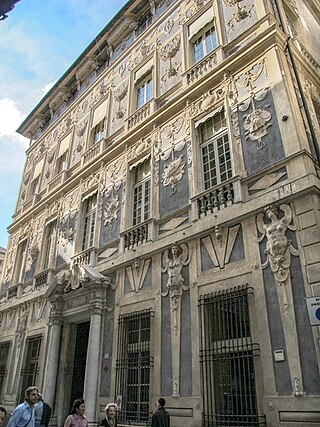
The palazzo Podestà or Nicolosio Lomellino is a building located in via Garibaldi (Genoa) at number 7 in the historical centre of Genoa, included on 13 July 2006 in the list of the 42 palaces inscribed in the Rolli di Genova that became World Heritage by UNESCO on that date.
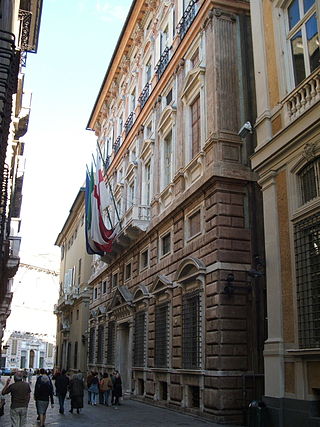
The Palazzo Carrega-Cataldi or Palazzo Tobia Pallavicino is a building located in via Garibaldi (Genoa) at number 4 in the historic centre of Genoa, included on 13 July 2006 in the list of the 42 palaces inscribed in the Rolli di Genova that became World Heritage by UNESCO on that date. The building is now the headquarters of Genoa's Chamber of Commerce.

The Palazzo Cosma Centurione is a building located in the historical centre of Genoa, in Via Lomellini at no. 8, included on 13 July 2006 in the list of the 42 palaces inscribed in the Rolli di Genova that became World Heritage by UNESCO on that date. Also known as the Palazzo Durazzo Pallavicini or Palazzo di Gerolamo III Pallavicino, from the name of its successive owners, due to its architecture and the frescoes preserved inside, it is an outstanding example of Genoese Baroque.
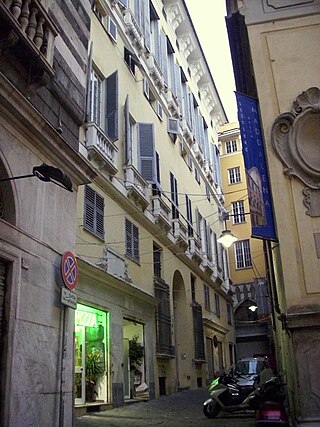
The palazzo Gio Battista Grimaldi is a building located in vico San Luca at no. 4 in the historical centre of Genoa, included on 13 July 2006 in the list of the 42 palaces inscribed in the Rolli di Genova that became World Heritage by UNESCO on that date.
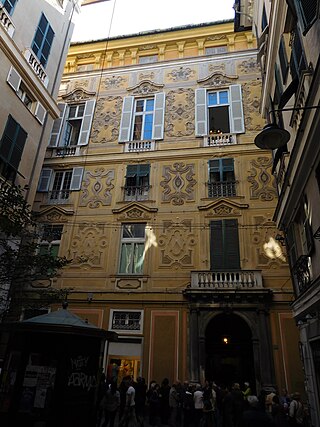
The Palazzo Nicolò Spinola di Luccoli, also called Palazzo del Marchese Stefano Franzone, or Palazzo Spinola Franzone, is a building located in Via Luccoli at number 23, in the area of the Soziglia Market in the historic centre of Genoa. The building was included in the list of palaces inscribed in the Rolli di Genova. The architecture, the decoration of the façade and the frescoes by Domenico Parodi in some of the interior rooms make it a relevant example of Genoese Baroque.

The Palazzo Cattaneo Della Volta, also called Palazzo Cattaneo di San Torpete or Palazzo di Nicolò Cattaneo, is a building located in Piazza Cattaneo at number 26 in the historical centre of Genoa. The building was included in the list of palaces inscribed in the Rolli di Genova.
References
- ↑ (in Italian) ...Il verdetto autorevole, importante, [su Strozzi] arriva da Ezia Gavazza ecc. Dal Supplemento Il Lavoro relativo a Genova uscito il 12 dicembre 2007 sul quotidiano La Repubblica
- ↑ "Arte, è morta la storica dell'arte Ezia Gavazza". Repubblica.it. 18 April 2019.
- ↑ (in Italian)Studio di Storia delle Arti, numero speciale in onore di Ezia Gavazza, Genova, SAGEP Ed., 2003 ISBN 88-7058-900-5 and Domenico Piola: frammenti di un barocco ricostruito, restauri in onore di Ezia Gavazza, Genova, SAGEP Ed., 2003, ISBN 88-7058-899-8, quest'ultimo volume con studi specifici su Domenico Piola
- ↑ "Biographical outline of Bernardo Strozzi" (in Italian). Archived from the original on 2006-05-15. Retrieved 2020-03-24.